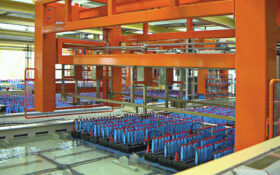Researchers at the U.S. Department of Energy’s (DOE) Argonne National Laboratory have used artificial intelligence to study the inner workings of redox flow batteries.
The team, led by Argonne chemist Rajeev Surendran Assary, investigated how chemical energy is stored in dissolved molecules that interact with electrodes in flow batteries.
The team at the Joint Center for Energy Storage Research (JCESR), a DOE Energy Innovation Hub led by Argonne, investigated the storing and releasing of energy with materials called redox active polymers, or redoxmers, which are based on larger molecules, each with tens of charge storing elements.
A paper based on the study, ’Quantum chemistry-informed active learning to accelerate the design and discovery of sustainable energy storage materials’ was published in Chemistry of Materials.
Assary and his colleagues designed a redoxmer— that could be electrically cleaved at a particular voltage, freeing it to re-enter the electrolyte solution— after noticing that an inactive film formed when the battery cycled.
To find the correct redoxmer, the team used Argonne’s Bebop supercomputer at the Laboratory Computing Resource Center to run a set of 1,400 different redoxmer’s using density functional theory (DFT) calculations.
Experimentally, it can take months to synthesise and test a dozen redoxmers but using the machine learning technique called active learning the team was able to find the ideal molecules from a dataset consisting of more than 100,000 redoxmers without running extensive DFT calculations.
This larger dataset included redoxmers that were structurally similar to those in the original DFT dataset in so far as both sets of molecules used the same scaffold. However, because of the different ways the functional groups were populated, the properties diverged.
Assary and his colleagues trained the model on a handful of different ‘redoxmer’ possibilities.
Assary said that to identify 30 molecules with the desired properties from an initial dataset of 1,400, only took 70 picks. With random picking, only 9% of picks would have been successful, representing a fivefold improvement.
When the same approach was applied to the 100,000+ dataset, it successfully found 42 desired molecules within 100 picks.












